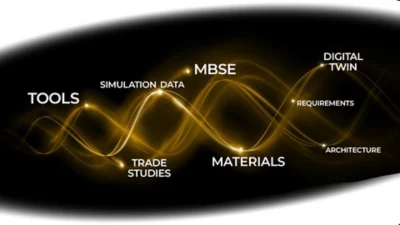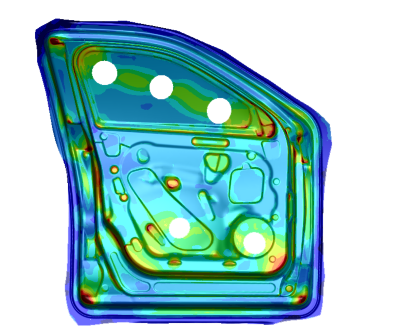
Ansys 2024 R1 distinguishes itself through a unified interface that simplifies complexities and enhances efficiency. Our native integration breaks down barriers in collaborative engineering environments, fostering real-time interactions and elevating project outcomes. The inclusion of a visually appealing Dark Mode and a modern design demonstrates our commitment to innovation, providing users with an aesthetically pleasing and more productive experience. Watch the video below to learn more.
3D Design
Ansys Discovery’s latest release focuses on effortless precision, smart model preparation, and accelerating design exploration. Effortless precision enhances simulation accuracy up to 10X with local fidelity refinement, reducing GPU memory requirements. Smart Model Prep cuts setup time by 50X with automated weld creation and associative physics transfer. Accelerating design exploration introduces the optiSLang plug-in for optimization, sensitivity studies, and one-click burst to cloud capability, allowing up to 100 parallel simulations on Ansys Cloud.

Acoustics
Ansys Acoustics 2024 R1 gives all Mechanical enterprise users access to Sound Analysis and Specification (SAS) to perform acoustic analyses and create more pleasing sounds quickly. Data Processing Framework (DPF) Sound now includes psychoacoustics indicators, enabling users to estimate how humans perceive sound.

Additive
Ansys’ latest Additive Manufacturing (AM) release enhances 3D printing through Fidelity, Usability, and Optimisation. Focusing on Fidelity, it ensures precision in capturing process parameters like LPBF and DED. Usability enhancements include streamlined workflows and tools like LPBF Setting Template Save/Load, simplifying job setup. Optimisation features like Distortion Compensation restart and DED Auto-dwell time boost productivity by automating complex processes. This release underscores Ansys’ commitment to advancing additive manufacturing.

Autonomous Vehicle Simulation
Continuing the momentum for Autonomous Vehicle Simulation from our last release, 2024 R1, takes the innovations one step further. Keeping safety as the first and foremost objective, most improvements in this release deliver on the critical aspects that elevate the development of ADAS/AD features. With notable enhancements in overall integration and connectivity, radar sensor simulation, and industry-mandated virtual headlamp regulation, this release covers many innovations to help our users design the most robust industry solutions.

Connect
Ansys 2024 R1 introduces AI-powered optimisation, MBSE connectivity, and sustainable Material Intelligence to simulate earlier in design, enabling faster product development to Ansys Connect. The system allows engineering analysis of verified requirements using ModelCenter, connected to the Ansys Systems Architecture Modeler. The new sustainability add-on, Granta MI, helps make earlier material decisions. The enhanced UI/UX accelerates collaboration and integrates process and data management, requirements verification, optimisation, and materials management capabilities into the everyday simulation UI.

Digital Missions Engineering
The 2024 R1 release of Digital Mission Engineering (DME) introduces new features for mission-level simulation, including enhanced subsystem and sensor payload modeling, updated tools for large platforms, asset grouping, and Python scripting and API enhancements. These improvements improve workflows, fidelity, and performance analysis and align with space mission design and operation needs.

Digital Twin
Ansys 2024 R1 Digital Twin offers simplified optimization algorithms for parameter calibration, improved fusion workflow with multi-file selection, transient response for static parameters, visualization in SRB interface, and support for new Mechanical applications through LS-DYNA.

Electronics
This release includes significant advances in simulation performance, meshing, and automated workflows. It covers various applications such as combined chip-package-PCB simulation, RF, HPC, 3D IC, and electric motors. New capabilities include ECAD-MCAD integration in Ansys Maxwell for flex and rigid PCBs, adaptive templates in Ansys Motor-CAD, and multi-solver interoperability for multiphysics and multiscale solutions.

Embedded Software
Ansys is launching a new product called Scade One, a model-based solution for developing embedded applicative software. Scade One enables a seamless Model-Based Systems Engineering (MBSE) process thanks to its openness and reliance on standards. Building on decades of experience in safety-critical systems development, Scade One is accessible to any company developing safe and reliable embedded software, thanks to this brand-new, entry-level offering. Accessible to system designers and embedded programmers, Scade One bridges the gap between the ease of use of model-based tools, with an intuitive user interface, and the power of generic-purpose programming languages to develop applications from traditional control software to complex mission and autonomy software.

Fluids
Ansys Fluids 2024 R1 updates include enhancements across solver performance, end-user productivity, and complex application workflows. The Fluent GPU solver now supports new physics and a new Fluent web UI that allows you to view post-processing in real time via a web browser. Ansys CFX and Turbo Tools have improved blade modeling features, while Ansys Rocky offers enhanced DEM simulations and improved SPH capabilities.

Materials
Design for sustainability with material intelligence. The new sustainability add-on for Ansys Granta MI offers a rich toolset and the data to support sustainability experts, materials experts, and designers in their engineering efforts to reduce product environmental footprint early in the design phase.

Optics
2024 R1 Ansys Optics enhances simulation capabilities for optics and photonics designers. The release includes new features for high-efficiency multiscale optics simulation and analysis, including metalens simulation, streamlined straylight analysis, and compatibility with other Ansys products.

Safety Analysis
Ansys Medini analyze includes two new components for the 2024 R1 release: the Digital Safety Manager (DSM) and a Digital Collaboration Server. The DSM is a web application for safety managers, while the DCM provides a centralised project management platform. The scripting API is improved for easier customisation.

Structures
For 2024 R1, the structures product line introduces new features, enabling users to solve more complex problems efficiently. Mechanical introduces new dark and light user interface themes to increase flexibility and maintain a consistent user experience across Ansys products. Mechanical also has significant enhancements to streamline vibro-acoustics workflows, including a dedicated noise, vibration, and harshness (NVH) meshing workflow and expanded product packaging capabilities. The fast Lanczos solver in LS-DYNA drastically improves speed and accuracy for large models with many computed modes. With PySherlock, Python programming is made easy, and Sherlock is now compatible with Linux.


Ansys 2023 R1 enables engineering teams to handle the complex challenges required to develop the next generation of world-changing products. Advances in product design drive the ability to replicate the behaviour of complex systems so you can find novel solutions. The new products, technologies, and tools that make up 2023 R1 enable engineering teams to examine products and systems rigorously under varying conditions. Simulation allows stakeholders to expand their knowledge and optimize designs at every stage of the product development process.
3D Design Updates
Ansys 2023 R1 expands Discovery’s astonishing live physics, innovative user experience, and robust modeling tools, making it a critical piece of the Ansys digital simulation thread and the best place to start simulation for every engineer and analyst.

Acoustics Analysis Updates
In 2023 R1, Ansys Sound updates include new enhancements to the Sound Analysis & Specification (SAS) module, allowing users to access integration & differentiation tools to convert, display and analyze (time, spectrum, spectrogram) vibration signals. Updates to the Virtual Reality Sound (VRS) module include the ability for users to accurately play multichannel sound files on multiple speaker setups for any configuration, making the sound comparison as easy as possible. Finally, updates to the Active Sound Design for Electric Vehicles (ASDforEV) module includes access to a new sound design method called Granular Synthesis to rapidly sketch and tune active sounds from a single sound sample.

Additive Manufacturing Update
Ansys 2023 R1 continues expanding toolsets for Additive Manufacturing users, streamlining design, simulation, and manufacturing workflows. Adding new wizards for distortion compensation and scan pattern-based calibration automates the simulation setup process, reducing the need for lengthy manual setup.

Autonomous Vehicle Simulation Updates
From customised data labelling, improvements in the accuracy of Radar & Lidar sensor outputs, backend distributed & controlled processing, to an effortless handshake with the driving simulator – 2023 R1 updates are sure to impress AVxcelerate users.

Connect Updates
Ansys 2023 R1 builds on the capabilities of materials, SPDM, optimisation, and MBSE to amplify simulation benefits by improving engineering efficiency, supporting collaboration, and accelerating innovation. The Ansys Connect collection boasts UX improvements, new integrations, and ease-of-use features to connect the latest processes, tools, and data readily for different engineering teams.

Digital Mission Engineering Updates
The latest release of STK continues to expand and enhance integration across Ansys multiphysics solvers, boosting confidence in early concept system design, improving decision-making, and improving the efficiency of the engineering process.
- Enhanced Radar Clutter Modeling
- Integrated EOIR Thermal Model Loading from Aviator
- Cislunar Support

Structures Updates
In 2023 R1, the Structures Product Line delivers new features and capabilities that allow our users to perform more accurate, efficient, and customizable simulation analyses, including:
- An AI/ML Resource Prediction feature to provide estimates on expected solve time and memory usage required to solve an Ansys Mechanical simulation.
- Efficiently modify a CAD model without losing the associativity of the model’s features after setup, using geometry-based re-associativity with the Scoping Wizard that detects and reestablishes scoping in Mechanical.
- Improvements to LS-DYNA Incompressible Smooth Particle Hydrodynamics (ISPH) for improved data processing, better visualization, data transfer to Mechanical and Fluent, and more.
- Comprehensive battery safety workflow in LS-DYNA simulates thermal runaway following thermal and mechanical abuse. Predict the combined structural, electrical, electrochemical, and thermal (EET) responses of automotive batteries – validated through experiments.
- Enhancements to the Ansys Sherlock parts library include over 400,000 new parts added, allowing users to build more accurate models for analysis. Additionally, improved integrations between Sherlock, Mechanical & Icepak can handle multiple PCB assemblies for motherboard or daughter board applications.



